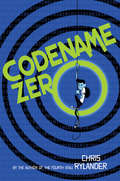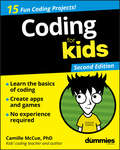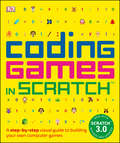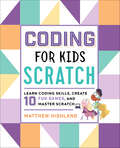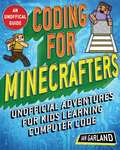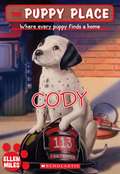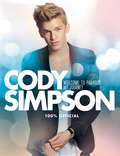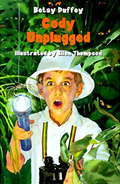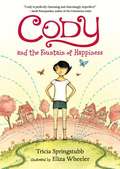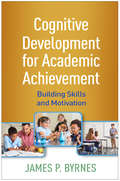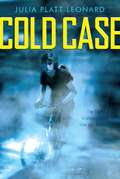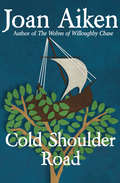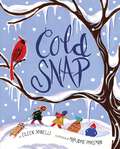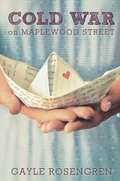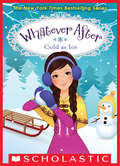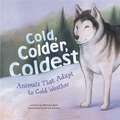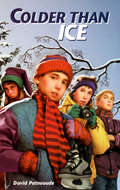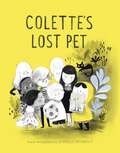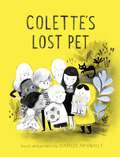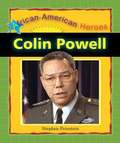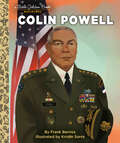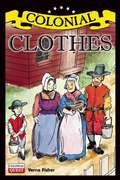- Table View
- List View
Codename Zero (Codename Conspiracy #1)
by Chris RylanderFrom Chris Rylander, author of The Fourth Stall, comes an incredibly funny and clever mash-up of middle-grade school story and spy adventure, in the vein of H.I.V.E. and NERDS.There are places in the world where heroes are born. There are places where brave men and women fight a never-ending battle against evil in order to keep our country and all other countries safe. There are places where the fate of our planet is being decided, even at this very moment, the consequences of which will echo through history.None of these places is in North Dakota.Carson Fender, seventh grader and notorious prankster, knows this. He's lived in North Dakota for his entire life, going to the same boring school every day, the same boring movie theater every week, the same boring state fair every year. Nothing ever changes, and nothing ever happens. That is, until today. Because today a desperate man hands him a package with a dire set of instructions. And that package is going to lead Carson to discover that there's a secret government agency operating in his small, quiet North Dakota hometown.And that this agency needs his help.
Codes: How to Make Them and Break Them! (Murderous Maths Ser.)
by Ian Baker Kjartan PoskittDid you ever want to send a message that only your friend can read? Or did you want to try and uncover a secret communication from someone else? If so, then here's everything you need to know about creating and cracking codes-from the simplest substitution messages to the secrets of the well-known World War II coding contraption, the amazing Enigma Machine!The book includes information about:Substitution codesScrambling codesCodes containing unrecognizable symbolsOther message systems such as Morse code and flagsAnd how to make your own Enigma machine!You’ll be thrilled as this amusing book takes you on a codebreaking adventure, learning ways to decode both simple and difficult puzzles, as well as provides you with a history on the cryptology. Filled with tips and enjoyable illustrations by Ian Baker, Codes will have you sending secret messages in no time.
Coding For Kids For Dummies (For Kids For Dummies)
by Camille McCue Ph.DA guide for kids who want to learn coding Coding is quickly becoming an essential academic skill, right up there with reading, writing, and arithmetic. This book is an ideal way for young learners ages 8-13 who want more coding knowledge than you can learn in an hour, a day, or a week. Written by a classroom instructor with over a decade of experience teaching technology skills to kids as young as five, this book teaches the steps and logic needed to write code, solve problems, and create fun games and animations using projects based in Scratch and JavaScript. This 2nd Edition is fully updated to no longer require any limited-time software downloads to complete the projects. Learn the unique logic behind writing computer code Use simple coding tools ideal for teaching kids and beginners Build games and animations you can show off to friends Add motion and interactivity to your projects Whether you’re a kid ready to make fun things using technology or a parent, teacher, or mentor looking to introduce coding in an eager child’s life, this fun book makes getting started with coding fun and easy!
Coding Games in Scratch: A Step-by-Step Visual Guide to Building Your Own Computer Games (DK Help Your Kids)
by Jon WoodcockScratch 3.0 has landed! Stay ahead of the curve with this fully updated guide for beginner coders.Coding is not only a highly sought-after skill in our digital world, but it also teaches kids valuable skills for life after school. This book teaches important strategies for solving problems, designing projects, and communicating ideas, all while creating games to play with their friends.Children will enjoy the step-by-step visual approach that makes even the most difficult coding concepts easy to master. They will discover the fundamentals of computer programming and learn to code through a blend of coding theory and the practical task of building computer games themselves. The reason coding theory is taught through practical tasks is so that young programmers don't just learn how computer code works - they learn why it's done that way. With Coding Games in Scratch, kids can build single and multiplayer platform games, create puzzles and memory games, race through mazes, add animation, and more. It also supports STEM education initiatives and the maker movement.Follow Simple Steps – Improve Your Skills – Share Your Games!If you like playing computer games, why not create your own? Essential coding concepts are explained using eight build-along game projects. Coding Games In Scratch guides young coders step-by-step, using visual samples, easy-to-follow instructions, and fun pixel art. This coding book for kids has everything you need to build amazing Scratch 3.0 games, including thrilling racing challenges, zany platform games, and fiendish puzzles. Follow the simple steps to become an expert coder using the latest version of the popular programming language Scratch 3.0 in this new edition. Improve your coding skills and create your own games before remixing and customizing them. Share your games online and challenge friends and family to beat each other's scores! In this book, you will: - Learn about setting the scene, what makes a good game and playability- Discover objects, rules, and goals- Explore hacks and tweaks, camera angles, fine-tuning and controls- And much moreComputer coding teaches kids how to think creatively, work collaboratively, and reason systematically, and is quickly becoming a necessary and sought-after skill. DK's computer coding books for kids are full of fun exercises with step-by-step guidance, making them the perfect introductory tools for building vital skills in computer programming. Add Coding Projects in Scratch and Coding Projects in Python to your collection.
Coding for Kids: Learn Coding Skills, Create 10 Fun Games, and Master Scratch
by Matthew HighlandLearn to code awesome games with Scratch—a fun starter guide for kids 6 to 10Explore basic coding concepts and skills and start creating your own games right away! Coding for Kids: Scratch is a complete guide that makes mastering the Scratch programming language fun and easy for kids.From sprites and code blocks to scripts and scorekeeping, Coding for Kids: Scratch helps you discover everything you need to know to create 10 amazing games that you and your friends can play. Watch your confidence grow with step-by-step instructions and clear directions that keep things simple—even as the games you're making get more challenging. Game on!Coding for Kids: Scratch includes:Coding for kids—Learn Scratch terms and concepts, then use them to build games you can start playing immediately.Create 10 games—Cake Clicker, Dino Hunt, Crystal Keeper, and more—code, play, and share 10 cool games.Master Scratch—Simple directions, full-color screenshots, and projects that get more difficult make practicing Scratch a breeze.Make coding for kids fun and games with Coding for Kids: Scratch.
Coding for Minecrafters: Unofficial Adventures for Kids Learning Computer Code
by Ian GarlandLearn to Code while Adventuring through the Overworld!This fun and educational activity book Introduces kids to the world of coding through the Minecraft world they love. Colorfully illustrated characters and themes from their favorite video game bring the excitement of coding to life, while easy-to-follow screenshots guide them through activities. With adventures that include design, music, animation, gaming, and more, learners will discover tons of ways coding connects to other activities they love and how far a little imagination and invention can take them…to The End and beyond! Minecrafting-themed characters help kids become master coders Kid-friendly concepts and steps designed specifically for ages 8-12 Great games, mods, experiments, and more teach computational thinking—how to tackle large problems by breaking them down into a sequence of smaller, more manageable problems Whether brand-new to coding or looking for more hands-on learning, Coding for Minecrafters helps young coders advance in technology education by leaps and bounds—and have fun doing it!
Cody (The Puppy Place #13)
by Ellen MilesWill this Dalmation mischief-maker find a home before Halloween? Charles and Lizzie Peterson have a special talent when it comes to taking care of animals and somehow there always seems to be another dog who needs their help! So it is no surprise that Lizzie offers to lend a hand when an overly energetic Dalmatian is left on their porch. But after Cody destroys Lizzie's Halloween costume she's not certain she can convince the perfect owner to adopt him. Will this pup's curious teeth cost him a home?
Cody Simpson: My Journey
by Cody SimpsonThe first official all-access look into the life of singing sensation Cody Simpson. Follow Cody as he goes from singing cover songs in his bedroom to opening sold-out concerts for Justin Bieber. With never-before-seen photos, behind-the-scenes interviews, and exclusive information, this book is perfect for pop music fans and for Codys Angels.
Cody Unplugged
by Betsy DuffeyAll Cody Michaels wanted to do over summer vacation was relax with some cartoons and computer games. Instead, he's being unplugged -- and sent to Camp Bear! And as if wild animals, poison ivy and a camper nicknamed The Moose weren't bad enough, Junie Andrews has attached herself to him like a blood-sucking leech. Camp Scare would have been a better name for this place! The first rule in his wilderness survival book is to be prepared, but if Cody is going to make it through camp in one piece, he's going to have to come up with a few survival rules of his own.
Cody and the Fountain of Happiness
by Tricia Springstubb Eliza WheelerMiddle-grade readers drawn to Judy Moody or Clementine will find a funny and charismatic companion in Cody, star of this delightful new series. For whimsical Cody, many things are beautiful, especially ants who say hello by rubbing feelers. But nothing is as beautiful as the first day of summer vacation, and Cody doesn’t want to waste one minute of it. Meanwhile, teenage brother Wyatt is moping over a girl, Mom is stressed about her new job as Head of Shoes, Dad is off hauling chairs in his long-distance truck, and even camp has been closed for the summer. What to do? Just when all seems lost, Cody bumps into a neighborhood boy named Spencer who is looking for a runaway cat. With a new friend and a soon-to-be-found cat, Cody is on her way to the fountain of happiness.
Cognitive Development for Academic Achievement: Building Skills and Motivation
by James P. ByrnesThis integrative text spotlights what educators need to know about children's cognitive development across grade levels (PreK-12) and content areas. The book provides a concise introduction to developmental neuroscience and theories of learning. Chapters on general cognitive abilities probe such crucial questions as what children are capable of remembering at different ages, what explains differences in effort and persistence, and how intelligence and aptitudes relate to learning. Domain-specific chapters focus on the development of key academic skills in reading, writing, math, science, and history. Multiple influences on academic achievement and motivation are explored, including school, family, cultural, and socioeconomic factors. Each chapter concludes with clear implications for curriculum and instruction.
Cold Case
by Julia Platt LeonardA boy makes a terrible discovery and must clear his family's name in this action-packed thriller.When thirteen-year-old Oz Keiller stumbles upon a dead body, his life is thrown into a tailspin. His older brother is the prime suspect in the murder, and Oz soon learns that the crime may be tied to the death of his father years earlier--a father who was accused of selling nuclear secrets to rogue governments. The fate--and livelihood--of his family is hanging by a thread, and it's up to Oz to try and crack the case, with the help of his best friend, Rusty. It's a quest that has more twists and turns than the dusty roads of New Mexico--and the answer may be closer to home than Oz ever could have imagined.
Cold Shoulder Road (The Wolves Chronicles #9)
by Joan AikenIs Twite and her cousin, Arun, use their telepathic gifts to find Arun&’s missing mother in this gripping adventure set in an alternate British kingdom When Is Twite and her cousin, Arun, return to Cold Shoulder Road in Folkestone after their astonishing adventures in the North, the town is deserted and Arun&’s mother is missing. Some say she took off with the sect Arun was raised in before he ran away. Known as the Silent Folk, members of the group are not allowed to talk and must communicate through sign language. But there are others who insist that Ruth Twite is a witch. To make matters worse, Is&’s sister Penny has also vanished, along with the mute Handsel child. The only clue to all of their whereabouts is an elusive stranger called Admiral Fishskin. When Is and Arun finally track down the cult, Arun discovers that they have new leader. Evil, charismatic Dominic de la Twite plays dangerous mind games and is able to block telepathic communication between Is and Arun. The cousins also find themselves up against a band of smugglers called the Merry Gentry that is using hidden tunnels beneath the city to search for buried treasure. With its sprawling cast of Dickensian characters and imaginative historical and social setting, this gripping adventure will delight existing fans of the Wolves Chronicles and new readers alike. Cold Shoulder Road is the 9th book in the award-winning Wolves Chronicles, but you may enjoy reading the series in any order. This ebook features an illustrated personal history of Joan Aiken including rare images from the author&’s estate.
Cold Snap
by Eileen SpinelliWarm up with this charming neighborly tale about a small town determined to beat the deep freeze from a beloved picture-book author and a two-time Caldecott Honor illustrator! It&’s snowy cold in the town of Toby Mills. The thermometer is sinking toward zero, and the icicle hanging from the nose of General Toby&’s statue is growing closer to the ground. The newspaper headline reads &“COLD SNAP!&” The people of the town are losing hope—and the feeling in their toes—until the mayor&’s wife saves the day with a toasty treat.
Cold War on Maplewood Street
by Gayle RosengrenCold War anxieties play out in a sensitively told story set during the Cuban missile crisis in the 1960s, perfect for fans of Gary Schmidt and Kristin Levine. Joanna can't get over how her brother broke his promise to never leave like their dad did. Sam is thousands of miles away on a navy ship, and no matter how often he sends letters, Joanna refuses to write back. When she makes a promise, she keeps it.But then President Kennedy comes on TV with frightening news about Soviet missiles in Cuba--and that's where Sam's heading. Suddenly Joanna's worries about being home alone, building up the courage to talk to a cute boy, and not being allowed to go to the first boy-girl party in her grade don't seem so important. Maybe sometimes there are good reasons to break a promise.The tense timeline of the Cuban missile crisis unfolds alongside a powerful, and ultimately hopeful, story about what it means to grow up in a world full of uncertainty.
Cold as Ice: Cold As Ice (Whatever After #6)
by Sarah MlynowskiThe magical sixth installment in this NEW YORK TIMES bestselling series!Brrrrrrrr. This fairy tale is FREEZING! Even though my brother and I had decided to stay away from the magic mirror, our puppy had other plans -- he bounded right in. What choice did we have but to go in after him? When we land in a winter wonderland, we realize we must be in the story of The Snow Queen. And this fairy tale is nothing like the movie. This Snow Queen is super-mean, and she turns our dog into an ice sculpture!To get home we'll have to: - Defrost our furry friend- Ride a very chatty reindeer- Learn to ice-skate- Escape from a band of robbersAnd if we're not careful . . . we could end up frozen ourselves!
Cold, Colder, Coldest: Animals That Adapt To Cold Weather (Animal Extremes Ser.)
by Michael DahlDescribes some animals that survive extremely cold temperatures and the different ways that these animals stay warm. Some of the animals shown include the tundra bumblebee, the Alaskan blackfish, the polar bear, and the emperor penguin.
Colder Than Ice
by David PatneaudeJosh isn't happy to be starting at a new school, especially as it's almost Thanksgiving. But maybe it's a chance to be somebody--not so easy for a kid who's been pretty average and is overweight besides. So when big-shot Corey Kitchens wants Josh to join him and his friends for ice hockey on Poor Rooney's pond, Josh is pumped. He can see himself out there, with the cool seventh graders, a natural success for the first time in his life. He can hardly wait for the ice to get thick. But why is it that Skye, the girl with the warm smile, doesn't trust Corey? And why does Mark, the strange kid who has Asperger's syndrome (a form of autism), put up an umbrella to protect himself from the snow? Why does he say that the coming cold will test the heart? David Patneaude's new story is a compelling tale about real friends and real courage.
Colette's Lost Pet
by Isabelle ArsenaultColette can't find something to talk about with the new kids in the neighborhood...so she invents a pet! Her fib quickly escalates, and suddenly her parakeet is a larger-than-life world-traveler named Marie Antoinette. Have her new friends figured out her secret? What will they do?This charming story both clearly identifies the struggle of navigating a different experience, and demonstrates to kids a lovely and welcoming way to treat someone new in their community.
Colette's Lost Pet (A Mile End Kids Story #1)
by Isabelle ArsenaultA charming and funny story about navigating new places and friendships. Perfect for fans of Uni the Unicorn and Sparky.Colette is exploring her new neighborhood and wants to make friends. But when she encounters someone her age she&’s never met before, she doesn&’t know what to say—so she hastily invents a lost pet! Things spiral a bit out of control as a neighborhood-wide search party is assembled and Colette makes her pet bird more amazing with each telling. Will the neighborhood kids catch on to her ever-growing fib? This charming story both clearly identifies the struggle of navigating a different experience and demonstrates to kids a lovely and welcoming way to treat someone new in their community.
Colin Powell (African-American Heroes)
by Stephen FeinsteinColin Powell was the first African American to be Secretary of State, following an illustrious career as a four-star general and Chairman of the Joint Chiefs of Staff. This easy biography is deal for early independent readers and useful for beginning reports.
Colin Powell: A Little Golden Book Biography (Little Golden Book)
by Frank BerriosHelp your little one dream big with a Little Golden Book biography about Colin Powell, the first African American US secretary of state! Little Golden Book biographies are the perfect introduction to nonfiction for young readers—as well as fans of all ages!This Little Golden Book about Colin Powell--the son of immigrants who became a four-star general and the United States' first Black secretary of state--is an inspiring read-aloud for young readers.Look for more Little Golden Book biographies: • George W. Bush • John McCain • My LGB About the White House • My LGB About Johnny Appleseed
Collision Course: Collision Course (Titanic #2)
by Gordon KormanFrom bestselling author Gordon Korman, a second heart-stopping adventure aboard the unluckiest ship of all.The Titanic has hit the high seas--and moves steadily toward its doom. Within the luxury of the cabins and the dark underbelly of the ship, mysteries unfold--a secret killer who may be on board, a legacy that may be jeopardized, and a vital truth that will soon be revealed. For Paddy, Sophie, Juliana, and Alfie, life on the Titanic brings both hiding and seeking, as their lives become irrevocably intertwined. And then, of course, an iceberg appears, and the stage is set for the final scene.
Colonial Clothes (Colonial Quest)
by Verna FisherTaking young readers on a journey back in time, this dynamic new series showcases various aspects of colonial life, from people and clothing to homes and food. Each book contains creative illustrations, interesting facts, highlighted vocabulary words, end-of-book challenges, and sidebars that help children understand the differences between modern and colonial life and inspire them to imagine what it would have been like to grow up in colonial America. The volumes in this series focus on the colonists but also include relevant information about Native Americans, offering a variety of perspectives on life in the colonies. Looking at the clothing that men and women wore in colonial times, this book examines how fabrics were made and discusses the work of various professions related to clothing, including tailors, cobblers, tanners, milliners, and wigmakers.
